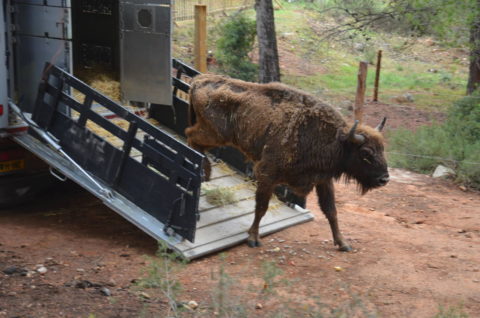If you think mosquitoes are a nuisance, just try swatting bison and see how far you get!
And yet the good people of Benagéber can once again hear the sound of hooves as their ancestors did before them, and of Buffalo Bill and some pesky Indians exchanging slugs and arrows of outrageous bison while disputing the pros and cons of modern progress versus a life in harmony with nature.
The project to bring bison to Benagéber became reality on April 23rd and 29th 2016, due no doubt to popular demand.
12 European bison have been released into Valdeserrillas nature reserve, Spain, this week in the largest bison reintroduction ever in Western Europe. True Nature Foundation collaborated with the European Bison breeding programme of the European Association of Zoos and Aquaria (EAZA).
The first seven bison, from Fota Wildlife Park, Ireland, arrived earlier this week. Another five European Bison from Howletts Wild Animal Park and Port Lympne Reserve, United Kingdom, have joined the herd today. Both parks work in conjunction with the Aspinall Foundation who also provisioned the transport of the UK animals to Spain.
The release of the European Bison, or Wisent, as they are known in Europe, is part of an ambitious project to restore the once seriously endangered large herbivore to its former ecological range.
European bison were driven to extinction in the wild in the early twentieth century as the result of habitat destruction and severe hunting. Through the captive breeding of the species in European zoos and a series of reintroduction projects, the population has gradually begun to increase and the IUCN subsequently reclassified European bison as Vulnerable, rather than Endangered.
The Nature Reserve of Valdeserrillas is the lucky location chosen for this revolutionary decision to reintroduce a species that died out in the area 10,000 years ago, ignoring the suspicion that there might have been very good reasons in favour of their extinction.
Over here in Europe, the last wild bison died in 1919 in Poland, and since then the potato crop has flourished in that country, as have citric fruits and delicate hoof level vegetables here on the Valencian coastal plain, where unending miles of prairie grass are a rare sight.
There are now about 4,000 bison in Europe, in zoos and safari parks, although so far, attempts to turn them into cuddly pets have failed miserably.
In Spain there are a few living in captivity in Palencia and Asturias, and not much else.
Until now!

